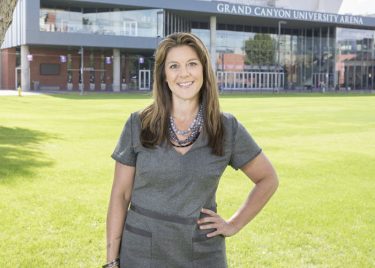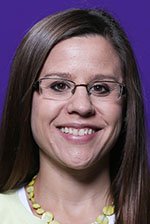
By Rick Vacek
GCU News Bureau
Teaching at Grand Canyon University is a lesson in collaboration, and that’s more apparent than ever as the 2017-18 academic year begins.

Ground and online faculty collaborate on valuable teaching resources that can be used in all modalities. The fact that online faculty work on campus is a major differentiator for GCU, as is the fact that the University has what Mark Alexander, Senior Vice President of Curriculum and Content Services, calls a “collaborative curriculum.”
Put it all together, and it smooths the process of sharing and facilitating ideas and also enables administrators to ask an important question:
“One of the things we’ve been talking a lot about with both ground and online faculty: What is next in terms of teaching and learning?” said Kelly Palese, Vice President of Faculty Operations. “What are we going to do that sets us apart from everybody else? How are we going to ensure that when we walk into the classroom or log into the classroom everything we do as instructors is leading to student learning and better student outcomes?
“We’ve got faculty teaching what we call a mixed-modality model – those folks could be teaching ground classes, online, cohort, any mixture of all three. They’re bringing their expertise from a different modality to other modalities. They’re able to use some of their resources to reach both 18-year-old students and 50-year-old students.”

The ideas were flowing last month when faculty, both ground and online, gathered in GCU Arena before the start of the academic year for a weeklong conference. Palese said she sensed more excitement than ever from everyone – especially adjunct faculty members, who attended in greater numbers than ever before.
“They loved it,” she said. “They loved the discipline-specific, course-specific discussions within each of the colleges. We got amazing feedback from the adjuncts. They’d say, ‘This is why we want to adjunct at GCU. We like teaching at GCU because you make us feel like we’re a part of all that.’
“They actually can have some input and can discuss things with their colleagues. One adjunct said he took a day and a half off of work from his regular job just to be there. They want to be part of it, and I think that makes a big difference.”
Not only did they take part in discussions, they led them. One of the online full-time faculty presenters was Jillian Hartman, who joked that her workshop made her “edu-famous.”
Hartman’s claim to fame is that she’s an ambassador for Flipgrid, one of the new Web 2.0 tools being used to connect more effectively with both ground and online students. It’s like Skype except that the users don’t have to be online at the same time.

“It’s a very organized, simple tool,” Hartman said. “This is a way to know who my students are. The feedback from them is fantastic.”
Another commonly used 2.0 tool is Remind, which features text messaging that allows the cell phone numbers of instructors and students to remain private. It enables communication between any combination – instructor to one student, instructor to a particular group of students, student-to-instructor or student(s) to student(s).
“It’s easy, it’s free and there’s no downside,” said Brian Clark, another online faculty member who was a presenter at the conference.
Clark noted that this wasn’t the typical conference where “teachers are forced into meeting where they have to go and don’t get a lot out of it.”
This was ground and online faculty doing presentations together … or sitting at the same big table with instructors in the same college to share ideas … or just building relationships. They did all this while being able to choose from a wide variety of workshops.
“Good teaching transcends the modality,” he said.
Said Hartman, “It was really beneficial to bring together the modalities. It created some really cool opportunities for collaboration, even after the conference. It’s all about innovation and sharing. We find creative ways to help students the best way we can no matter what modality we’re in.”
And that’s what it all points back to – the students. As Palese noted, “Whenever you have contact with students, they should be learning.”
She added, “It’s pretty awesome to have a faculty that is very nimble. They want to be part of solutions. They’re vocal when there are issues, but they’re vocal with solutions.”
After all, you can’t have collaboration without communication or cooperation. When done right, it can be quite a combination.
Contact Rick Vacek at (602) 639-8203 or [email protected].















